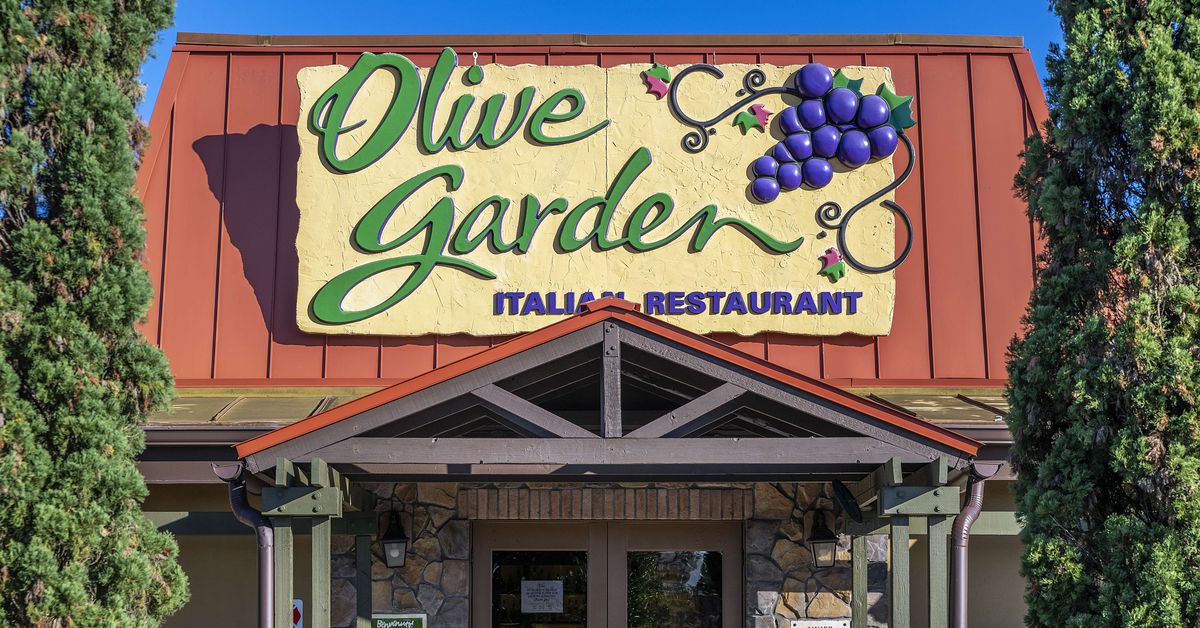
For years, millennials were blamed for the death of the casual chain restaurant. You know the kinds of places I’m talking about — an Applebee’s, a Longhorn Steakhouse, a Chili’s. The pundits insisted that millennials wanted trendier eats, not a basket of chicken wings and a bottomless Long Island Iced Tea, and you know what? They were right. We did demand more diverse flavors, better ingredients, and restaurant spaces that felt hip and fun and convivial. But after three years of a pandemic and all the havoc that it has wrought on the world of hospitality, the tide might be turning.
I first had this thought on a recent visit to my nearest Olive Garden. It was right next to my favorite antique mall, and after an hour or so of browsing a bunch of dusty old junk, nothing sounded more delicious than a feast of soup, salad, and breadsticks. When I arrived, midday on a Saturday, the place was packed. Families were told that they’d wait upwards of 20 minutes for a table, and most of them stuck around to do just that. After gorging myself on chicken gnocchi soup and Alfredo-dipped breadsticks, I stepped outside into the parking lot that the OG shares with a few other chain restaurants, and it was full.
Olive Garden sales have, in fact, been on the rise in recent years. The chain has seen upwards of 11 percent growth across the country in recent quarters, in a time when the company’s own predictions indicate that the American economy is slowing. The same growth is happening at other chains, too. Applebee’s saw massive sales growth in 2021 and 2022. Kentucky-based steakhouse Texas Roadhouse is currently the fastest-growing restaurant brand in the world, according to valuation consultancy Brand Finance. And fast-casual chains, like Chipotle and Panera Bread, have been booming for years, with no signs of slowing in that sector. Hell, even Quizno’s is mounting a comeback. Meanwhile, growth in fine dining has been much more meager. But even if you look to fine dining, the restaurants that have become chains — think Carbone and Nobu — are also thriving.
Perhaps the most curious of these casual comebacks is the Melting Pot, a stalwart fondue chain and the fanciest prom dinner date destination of the 1990s. Founded in Florida in 1975, the chain is currently in the process of giving more than 90 of its restaurants, some of which are decades-old, a major facelift. The Melting Pot is also looking for new franchise operators in various locales in an effort to open as many as 30 new locations in the coming year. It’s a comeback that’s been in the works since 2021, when diners who’d been cooped up in their homes for too long started seeking out restaurants where they could socialize.
But why, exactly, are so many people turning to chain restaurants now? The most obvious answer is cost. In this era where everything feels more expensive than ever, chain restaurants offer meals that are reliably affordable. And, considering that Applebee’s offers a free kids meal with the purchase of an adult dinner, it’s a real bargain for anyone who’s trying to feed a family right now. Because of their scale, chains are more able to offer these kinds of deep discounts than independent restaurants without completely destroying their bottom line.
And then there is the issue of consistency. Food is expensive, and no one wants to drop $40 on dinner at a new hotspot just for that dinner to be mediocre. You know you’re going to like your Bourbon Street Steak at Applebee’s because it’s going to be exactly the same as all the times you’ve had it before. It’s also important for the food-obsessed among us to remember that many people aren’t trying to eat the latest and greatest in culinary developments, they’re just trying to get a good meal at a fair price. They don’t want to hear about the farm-to-table history of the chicken, and they’re certainly not willing to pay $5 more just because the bird was raised and dispatched nearby.
I think we’re coming back to chains for both of those reasons, but don’t count out nostalgia as a third major factor. Olive Garden’s breadsticks are affordable and consistent, yes, but for millennials like myself, they’re also a reminder of a simpler time. A time when you thought going to the Olive Garden was a fancy night out, not dropping $500 on a bunch of small plates at some new hotspot where the chairs hurt your back a little. These chain restaurants may not be cool or sophisticated, but they are cozy and familiar, and I think many folks (myself included) would honestly prefer that to waiting in line at a hip eatery.
It’s also true that we live in a time of “chainification,” and that’s a phenomenon that isn’t just limited to the restaurant industry. It’s also happening in retail, in hotels, even nail salons and ear piercing studios, as corporations look for their own piece of the pie in industries that have traditionally been dominated by small, independently run businesses. In this moment, chains are nigh unavoidable. Whether or not their rising popularity is actually good for the dining landscape, though, is an entirely different question.
